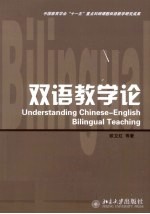

双语教学论PDF电子书下载
- 电子书积分:12 积分如何计算积分?
- 作 者:欧卫红等著
- 出 版 社:北京市:北京大学出版社
- 出版年份:2009
- ISBN:9787301158326
- 页数:319 页
Chapter One Basic Theories 1
1.1 Theories of first language acquisition and learning 1
1.1.1 Language acquisition and language learning 1
1.1.2 Theories of first language acquisition 2
1.1.3 Language acquisition view of cognitive linguistics 9
1.1.4 Language development 12
1.1.5 The critical period hypothesis 14
1.2 Theories of second language learning and acquisition 18
1.2.1 Critical period of second language learning and acquisition 18
1.2.2 Theories of second language acquisition 20
1.2.3 Practical pedagogical implications of SLA research 27
1.2.4 Individual learner differences and second language acquisition 30
1.2.5 Interlanguage 35
1.3 Theories of bilingual learning and acquisition 43
1.3.1 Appellation 43
1.3.2 Definitions 44
1.3.3 Types of bilingual teaching models 44
1.3.4 Bilingual education examples across the world 47
1.3.5 Chinese-English bilingual teaching in China 55
1.3.6 The critical period hypothesis of bilingual teaching 60
Chapter Two Teaching Methodology 67
2.1 Main ideas about English teaching methodology 67
2.1.1 Language and language teaching 67
2.1.2 The New National English Curriculum 72
2.1.3 Current English teaching methodology 73
2.1.4 Lesson planning 81
2.1.5 Classroom management 87
2.1.6 Assessment in language teaching 88
2.1.7 Classroom English 90
2.2 Main ideas about subject methodology 93
2.2.1 Main ideas about math teaching methodology 93
2.2.2 Main ideas about science teaching methodology 104
2.2.3 Main ideas about music teaching methodology 113
2.3 Main ideas about bilingual teaching methodology 125
2.3.1 Teaching goals 125
2.3.2 Teaching models and strategies 126
2.3.3 Code-switching 134
2.3 4 Bilingual teaching methodology in some subjects 173
Reference books 182
Chapter Three Grammatical Points for Bilingual Teaching 185
3.1 Verb and tense 185
3.1.1 Main verbs 185
3.1.2 Auxiliaries 186
3.1.3 Tenses 187
3.2 Subject-Verb concord 192
3.2.1 Brief introduction about concord 192
3.2.2 The common rule of agreement 193
3.3 Participle 196
3.4 Commonly used sentence patterns 197
3.4.1 Existential sentence pattern 197
3.4.2 It-patterns 197
3.4.3 Conditional sentences 198
3.5 Simple sentence 199
3.5.1 Positive and negative statements 199
3.5.2 Questions 200
3.5.3 Commands 201
3.5.4 Exclamations 202
3.6 Clause 202
3.6.1 Clause element 202
3.6.2 Basic clause types 202
3.7 Degree and construction 204
3.7.1 Degree of adjectives and adverbs 204
3.7.2 Typical comparative structures 205
3.8 Direct and indirect speech 208
3.9 Infinitive 209
3.10 Passive voice 209
3.11 Some issues 210
Reference books 213
Chapter Four Resources for Bilingual Classroom Teaching 215
4.1 Subject English words and expressions 215
4.1.1 Mathematics 215
4.1.2 Science 236
4.1.3 Music 248
4.2 Sample lesson plan analysis 276
4.2.1 Sample 1 276
Analysis of Sample 1 281
4.2.2 Sample 2 282
Analysis of Sample 2 284
4.2.3 Sample 3 285
Chapter Five Teacher Development 295
5.1 Introduction to teacher development and its research 293
5.1.1 Some concepts in teacher development 293
5.1.2 The importance of teachers'professional development 295
5.1.3 Approaches to teacher development 296
5.2 Teacher development in bilingual teaching 297
5.2.1 Building subject expertise 298
5.2.2 Improving Language proficiency 299
5.2.3 Developing bilingual teaching skills 300
Glossary and Index 307
- 《培智学校义务教育实验教科书教师教学用书 生活适应 二年级 上》人民教育出版社,课程教材研究所,特殊教育课程教材研究中心编著 2019
- 《指向核心素养 北京十一学校名师教学设计 英语 七年级 上 配人教版》周志英总主编 2019
- 《新课标背景下英语教学理论与教学活动研究》应丽君 2018
- 《大学英语教学的跨文化交际视角研究与创新发展》许丽云,刘枫,尚利明著 2020
- 《中国少数民族唢呐教学曲选》胡美玲编 2019
- 《卓有成效的管理者 中英文双语版》(美)彼得·德鲁克许是祥译;那国毅审校 2019
- 《语文阅读与写作教学研究》李玉红,陈晓玲,王芬著 2018
- 《语文教育教学实践探索》陈德收 2018
- 《中学语文教学案例研究》贺卫东主编 2019
- 《职业英语教学研究 2017-2018》刘晓晶 2018
- 《大学计算机实验指导及习题解答》曹成志,宋长龙 2019
- 《指向核心素养 北京十一学校名师教学设计 英语 七年级 上 配人教版》周志英总主编 2019
- 《大学生心理健康与人生发展》王琳责任编辑;(中国)肖宇 2019
- 《大学英语四级考试全真试题 标准模拟 四级》汪开虎主编 2012
- 《大学英语教学的跨文化交际视角研究与创新发展》许丽云,刘枫,尚利明著 2020
- 《北京生态环境保护》《北京环境保护丛书》编委会编著 2018
- 《复旦大学新闻学院教授学术丛书 新闻实务随想录》刘海贵 2019
- 《大学英语综合教程 1》王佃春,骆敏主编 2015
- 《大学物理简明教程 下 第2版》施卫主编 2020
- 《指向核心素养 北京十一学校名师教学设计 英语 九年级 上 配人教版》周志英总主编 2019
